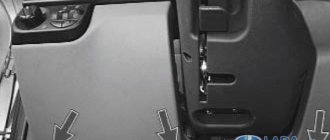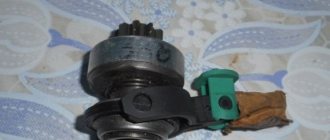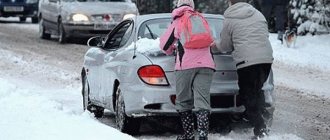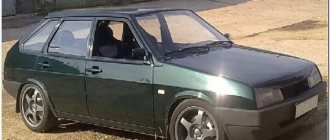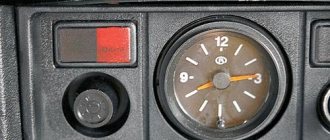Turning the ignition key, the driver observes the same picture every time. First, the instrument panel indicators light up to indicate the presence of fuel and battery charge. In the extreme position, the starter turns on and begins to rotate the crankshaft. To start a serviceable engine, a few crankshaft revolutions are enough, but what to do when the starter works, but the car stubbornly refuses to start? The culprit for this situation can be a variety of malfunctions, because the normal operation of the engine is ensured by several automotive systems at once.
Starting the internal combustion engine. How does this happen?
A car engine only works if several conditions are met:
- A sufficient amount of air-fuel mixture enters the cylinders.
- At a certain moment (at the end of the compression stroke), the spark plug generates a spark of the required power.
- The crankshaft and camshaft rotate with strict interaction, ensuring timely filling of the cylinders with the combustible mixture, proper functioning of the gas distribution system and operation of the fuel pump in carburetor internal combustion engines.
By turning the ignition key, the driver supplies power to the starter solenoid relay, which turns on its electric motor and ensures engagement with the crankshaft flywheel ring gear. As the crankshaft rotates, it converts angular momentum into reciprocating motion of the pistons and drives the camshaft (or shafts). The latter ensures timely opening of the valves, due to which the combustion chambers are filled with the fuel mixture at the right time.
The engine power system is responsible for its preparation and delivery. As soon as the piston reaches the top point at the end of the compression stroke, the fine fuel mixture is ignited by the spark formed on the spark plug (in diesel units, ignition occurs due to strong air compression). After this, the micro-explosion acts on the piston, which moves down and causes the crankshaft to rotate - this is what the engine starting diagram looks like.
What can you do?
Any motorist knows about the generator in the car for charging the battery. This is a special device that transmits electricity to the battery and on-board system from the engine.
Thanks to this technological process, you can additionally charge the battery. Fully charging the battery in this way is impossible due to a number of nuances:
- The battery cannot be fully charged during operation because it must be at rest.
- This technology allows charging only to start the engine.
- The charging process itself is very weak.
- When the generator is running, the battery is subject to high load.
Therefore, when the car does not start, the starter does not turn, the relay clicks, you should not really count on charging the battery in this way.
It is much more effective to replenish the battery charge in the standard way, using a charger. All energy will be restored in just a few hours, and the battery will be ready for use again.
If the situation is emergency, charging using a charger is still more important. Literally 20 - 30 minutes, and the battery will be partially charged.
If problems are detected with the power supply system, you need to take some actions:
- Using a screwdriver with a rubberized handle, unscrew the battery terminals;
- take zero-grit sandpaper and thoroughly clean the connecting wires and terminals;
- also use sandpaper to clean the contacts on the battery itself;
- check the battery charge;
- visually evaluate the connecting wiring supplying the starter for integrity;
- securely fasten the battery terminals, making sure that they will not become disconnected;
Having carried out all these manipulations, you should turn on the engine and evaluate the operation of the starting system.
If the starter does not turn, the relay clicks and crackles, you need to check the solenoid relay. To do this, voltage should be applied directly from the battery to the control terminal. It's not difficult to recognize her. Usually a thin wire leads to it. If the engine cranks normally, the failure of the solenoid relay will be confirmed.
Most often, burnt contacts are observed in the relay. To eliminate the malfunction, it must be dismantled, the contacts cleaned and reinstalled.
A repaired solenoid relay, by definition, will not last long. The fact is that factory treatment involves applying an erosion-resistant layer to the contact nickels.
Under normal conditions, applying this layer is impossible, so the next contact burnout is possible at any time.
Why does the starter turn normally, but the engine does not catch and does not start?
In half the cases when a car refuses to start, the starter is to blame. At the same time, the other half occurs in situations where the starter regularly rotates the crankshaft, but the engine starts only after repeated attempts or is completely silent. This could be due to a variety of reasons.
Driver inattention or negligence
The notorious human factor can manifest itself in the most unexpected ways. For example, a banal lack of fuel or an alarm that blocks the fuel pump. It also happens that some “well-wisher” clogged the exhaust pipe, or a careless driver, while backing up, got stuck in a pile of soil or a snowdrift. Such reasons do not fall into the category of technical malfunctions, but they can spoil a lot of nerves.
Technical problems - starter malfunctions
Every more or less experienced driver will distinguish the sound of a starter, which regularly rotates the engine, from the useless buzz of its electric motor when there is no engagement with the flywheel.
When starting to troubleshoot, you should definitely make sure that the starter is functioning normally, and that no extraneous knocks, clicks or malfunctions are observed during its operation. The starter is considered faulty in the following cases:
- The Bendix gear cannot engage with the flywheel ring gear. This manifests itself in a loud metallic grinding sound that appears when the starter is turned on. The reason for this phenomenon is wear of the mating surfaces, chipped teeth, etc. The solution to the problem is to install a new flywheel or ring. The latter can be rotated 180° and thus avoids the need to purchase a new part.
- The overrunning clutch or retractor relay mechanism is stuck. At the same time, the starter motor hums, but it makes no attempt to start the engine. In some cases, repeated attempts to turn on the starter help, but this only postpones the need for repair or replacement for some time.
- The crown is loose. A similar malfunction occurred on cars from the end of the last – beginning of this century, including the popular “nines”. In this case, the starter engages with the ring and begins to turn it, but it turns on the flywheel with a grinding noise. Only replacing the latter will help.
Video: Watch for anyone who has problems turning on the starter. Useful advice from an auto electrician.
The main reasons why the starter does not engage when starting a car
Before troubleshooting the operation of the main unit of the ignition system, you need to understand the causes of the breakdown. In accordance with the reason, an algorithm for repairing the device will be determined.
Low battery
The most common situation that car owners encounter is a low battery charge. When the voltage source is discharged or breaks down, the starter does not turn, the retractor does not click, which does not allow the engine to start.
When the charge is low, the starter does not work and the following symptoms appear:
- Turning the key does not start the engine. The starter unit does not make clicks or other sounds, and the device does not spin up. To diagnose the battery, you can try to activate another energy consumer. We are talking about optics, a car radio, a stove or interior lighting.
- The indicator lights on the control panel go out after turning on the ignition. Clicking sounds are also heard indicating that the starter relay is activated.
- The starter unit makes several clicks, and the indicator lights on the control panel go out or their brightness decreases.
Diagnostics of battery operation can be carried out using a tester or a load plug, an example of testing with a multimeter:
- The ignition is turned off and the hood of the car opens. The terminals must be cleaned, as poor current transmission may be due to oxidation of the contacts. For cleaning, it is better to use a toothbrush or fine-grained sandpaper. You must act carefully so as not to damage the top layer on the clamps.
- The clamps are disconnected. Wrenches are used to loosen the nuts on the contacts.
- A visual check of the battery housing is carried out. Battery malfunctions are often caused by damage to the case and leakage of electrolytic solution from the battery.
- If there is no damage, unscrew the caps on the battery banks. The presence of liquid inside the device is checked. If the electrolyte does not completely cover the jars, you need to add distilled water to the battery.
- The next step is to directly diagnose the battery voltage. The multimeter probes are connected to the battery terminals. When the engine is not running, the operating voltage parameter should be from 12.5 to 13 volts. You can diagnose the battery with the power unit running - it should be from 13.5 to 14 volts.
The battery technician spoke in detail about diagnosing a car battery using a multimeter.
If the battery voltage is more than 14.2 volts, then the battery is discharged and the generator device has to operate in enhanced mode.
To restore charge, the battery must be charged, and it is important to maintain the load current on the device. The charging procedure is carried out using starting-charging equipment; the task usually takes at least eight hours to complete.
The ignition switch is faulty
If the ignition switch does not work, this can be determined by the following symptoms:
- The starter unit is not functioning. The device does not make clicks and the relay does not operate. This problem is caused by a lack of power that must pass through the switch device.
- The electrical equipment installed in the machine does not function. Electrical appliances may not be connected to each other, for example, a stove and interior lighting. But activation of the equipment occurs as a result of the functioning contact component of the ignition switch.
- If the driver moves the key in the lock, some electrical equipment and devices may turn on at a certain position of the key. This indicates that the contact elements have closed and the power supply to the equipment has been restored.
All causes of malfunctions in the operation of the ignition switch can be divided into two groups - mechanical and electrical. Malfunctions in the operation of the lock always occur as a result of its incorrect installation or rapid wear of the components.
Malfunction of electrical components
Electrical problems usually occur due to overload of devices and equipment installed in the machine, the contact component breaks. With additional installation of lighting devices and other consumers, the ignition switch may not be able to withstand the increased load. Due to the increase in load, carbon deposits form on the contact component and appear on the metal part.
To prevent overload of the switching device, additional electrical equipment must be connected to the electrical circuit via a relay. The presence of this element will relieve part of the load. Problems in the electrical component of the lock may be caused by a short circuit in the electrical circuit. This malfunction is typical for all domestically produced cars; it is considered their “disease”.
The Auto Electrician HF channel spoke about diagnosing the ignition switch, checking electrical faults and ringing the device.
Mechanical failure
Mechanical malfunctions of the ignition switch include wear of the contact tracks or the contact elements themselves. The problem may be physical damage to one of the component components of the device. Also, the cause is often considered to be overheating of the contact elements and the plastic case; melting leads to the inoperability of the mechanism. To determine mechanical problems with the ignition switch, you will need to dismantle the device.
Diagnostics of the switching device is carried out using a multimeter or voltmeter:
- The negative cable is disconnected from the battery; a key is used to disconnect the wire from the clamp.
- The plastic upholstery around the steering column of the car is being dismantled. Depending on the car model, the dismantling procedure will be different. Usually, to remove the trim, it is enough to unscrew the bolts connecting the two parts of the trim to each other.
- The plug connected to the device is disconnected from the machine's power supply. The wiring harness is removed from under the control panel.
- The key is installed in the switch. It is necessary to rotate the control element to all available positions. You need to stop in each of them to use a tester to diagnose the resistance between the contact elements of the wiring. To check, the multimeter is switched to ohmmeter mode.
- If the test shows that the resistance value is 0, this indicates that the contact elements of the lock are working properly. When the operating resistance parameter corresponds to infinity, the contact components are non-working and must be replaced. If the resistance value is measured in numbers, this indicates burning of the contact elements.
- To diagnose the functionality of the backlight, you need to apply a direct current of 12 volts to the contacts. The example is considered on a Lada car, so current is supplied to components numbered 2 and 6 located on the connector. If the indicator light does not light up as a result of the action, this indicates a fault in the wiring or damage to the cable.
- If diagnostics show that some of the contact elements are faulty, it is necessary to completely replace the contact component.
Disconnecting the harness with electrical circuits from the machine network
Diagnostics of the contact component using a tester
Supplying current to contact elements 2 and 6 of the connector
Defective solenoid relay
Signs by which you can identify problems with the solenoid relay:
- The car engine starts, but after starting the power unit the starter unit does not turn off. You can hear the mechanism rotating, as evidenced by an unpleasant and loud buzzing sound.
- After turning the key, a click is heard in the ignition switch. This indicates that the starter unit is activated, but it does not start.
- When you turn the key in the switch, you can hear the assembly begin to unwind. But the crankshaft of the power unit does not rotate.
To verify that the solenoid relay is faulty, it must be checked; the diagnostic procedure is considered using the example of a VAZ 2110:
- The first stage of the test involves diagnosing the electrical circuit that goes to the relay. The wiring integrity is diagnosed. If there is a break, the circuit in the damaged area must be reconnected and insulated.
- If the power line is intact, then diagnostics of relay operation is performed. You will need help from another person. The assistant must turn the key in the ignition, and the car owner listens to see if a click is heard. If there is no click, it can be concluded that the relay is broken, so the device must be replaced.
- If there is a click and no turning of the starter mechanism, the relay is checked. Probably the component does not work as a result of burnout of the plates on the contact component.
- For diagnosis you will need a flat blade screwdriver. The terminal part that goes to the lock is disconnected from the relay, and the terminals are closed using a screwdriver. We are talking about an element that goes from the battery to the starter unit. This action will provide a direct supply of energy to the electric motor of the starter mechanism without a relay. If the unit begins to scroll, this indicates a malfunction in the relay.
- Then the voltage supplied from the starter unit is diagnosed; a tester is used to check. This step will allow you to find out exactly what the problem is - in the operation of the starter unit or in the electrical circuit and battery. For diagnostics, the tester contact is connected to the positive contact of the relay, and voltage is supplied to it from the battery. The negative probe of the tester must be connected to the ground of the car, that is, the body or any bolt screwed into the body.
- After connecting, the assistant needs to turn the key in the switch, the element is set to start mode. When you turn the key, the voltage parameter on the tester screen should be 12 volts. If the value obtained is lower, this may indicate a partial or complete discharge of the battery. The energy produced by the battery may not be enough to start the power unit, but it is enough to activate the relay. If there is a lack of electricity, the rotor of the starter device does not rotate.
Alexander Movchan spoke in detail about the procedure for diagnosing and repairing the solenoid relay.
Starter faulty
Signs of a malfunction in the starter mechanism:
- When you try to start the engine, the anchor element of the starter unit does not turn or turns with difficulty. The reason may be a discharge of the battery, oxidation of the surface of the clamps, or loosening of the terminal elements.
- When the ignition system is activated, the starter mechanism does not respond to the driver’s actions or turns the anchor element with great force. The battery is fully charged. The problem may be burning of the commutator device or natural wear of the anchor mechanism bushings. Also, the reason may be an interturn short circuit of the winding or surface wear on the brushes. Diagnostics will require disassembly of the mechanism and visual inspection of its components.
- When the starter device is started, the anchor element rotates, but the crankshaft of the power unit does not rotate. Perhaps the problem should be looked for in the failure of the coupling buffer ring. Sometimes the reason is that the drive ring is not working properly.
- If the engine is started, the starter mechanism does not turn off. The problem may be that the lever of the mechanism's drive device is stuck or that the traction relay is flooded. Sometimes the reason lies in the breakdown of the return spring element of the switch.
- When the starter unit is turned, noises, grinding, squeaking or other uncharacteristic and unpleasant sounds appear. The problem should be sought in the failure of the gear drive device. Often the reason lies in damage to the flywheel crown or wear of the bushings of the bearing devices.
To check a starter that does not allow the engine to start, proceed as follows:
- First, the rotation of the mechanism is checked. To do this, the assembly is securely fixed, the negative circuit is connected to the housing, and the positive contact goes to the upper terminal of the relay and activation contact. If the unit is working, the bendix should come out and start turning the gear with the electric motor.
- Then each component of the mechanism is diagnosed separately. To check the brushes, you can use a twelve-volt lamp with connected wires. One of the contacts of the light source is connected to the brush holder, and the second to the device body. If the light comes on, this indicates the need to replace the brushes as a result of breakdowns that have appeared in their protection.
- You can diagnose the brushes using a multimeter, but to do this the unit will have to be disassembled. The test is performed using an ohmmeter, which measures the resistance between the brush assembly and the main plate. With working brushes, the resistance parameter should correspond to infinity. When removing the brushes, you need to visually inspect them, as well as the bushings, windings of the armature device and the commutator unit. If the bushings are worn out, a voltage drop occurs when the engine starts, so the electric motor functions unstably.
- If the collector device fails or is damaged, the brush assembly will be “eaten up”. If the bushings are broken, the anchor assembly will be skewed and the brushes will wear unevenly. There is a possibility of an interturn short circuit in the winding of the device.
- To diagnose Bendix, the clutch body is clamped in a vice, and the assembly itself is rotated by physical force. If it scrolls, this indicates a problem with the overrunning clutch. The Bendix may not engage, and the assembly itself will begin to rotate. Visual diagnostics are used to check the gear, and sticking is determined through complete disassembly. When dismantling and disassembling, the gear unit is cleaned of dirt and lubricant residues inside the device.
- The winding of the starter assembly is diagnosed using a light source rated at 220 volts and a power of up to 100 watts. The diagnostic principle is similar to the procedure for checking the brush assembly. The light source is connected in series between the housing of the stator device and the winding of the mechanism. One contact of the electrical circuit is connected to the housing, and the second goes to the winding output; each of them is checked in turn. If the light source lights up, this indicates a breakdown.
- If there is no lamp, you can use an ohmmeter and measure the resistance value. This parameter should be approximately 10 kOhm. The winding of the rotor element is diagnosed in a similar way. For testing, a 220-volt lamp is used and one of its contacts is connected to the plate of the collector device, and the second to the core. If the light source is on, then it is necessary to rewind the winding or replace the rotor device.
- Armature diagnostics are performed by applying 12-volt voltage directly from the battery to the starter assembly. If the anchor element scrolls, then it is working. If there is no turning, the problem must be looked for in the device itself or the brushes.
The depth between the grooves of the commutator device of the anchor element should be at least 0.5 mm.
The VMazute channel showed in detail the procedure for disassembling the starter assembly with a description of the mechanism repair process.
How can I close the starter directly?
You can close the starter directly by connecting to the battery or through contacts. Both options work if the device’s anchor is not damaged.
Closing the terminals with a screwdriver, pry bar or wrench
If the traction relay is faulty, the direct closure method is used with any metal rod of the required length. This could be a screwdriver, wrench or pry bar. Problems with the retractor are indicated by a characteristic clicking sound when turning the key in the ignition switch. The starter at this moment is unable to crank the crankshaft, since the Bendix teeth do not cling to the flywheel crown. By closing the starter's power terminals, it will be possible to send current directly to the electrical windings. A wrench or screwdriver will take over the functions of the traction relay.
Before doing this, be sure to put the car on the handbrake and in neutral to avoid accidents. The tool itself should have an insulated handle and a fairly thick shaft. Therefore, it is recommended to use one of the items described above. The pry bar or key can be wrapped with electrical tape at the gripping point.
Closing contacts B and S, M and B is strictly prohibited! Explanation: B – Bold or thick wire – constant voltage contact. On many starters it is closed with a protective rubber cap and marked “+12”. M – Motor or electric motor. S – Start, the contact is made in the form of a threaded outlet, petal or plug, often closed with a plastic tip, so it must be removed before forced closure. 8 – negative contact, connected to the body.
On some car models (VAZ 2109, 2110, 2114), in order to bridge the starter with a screwdriver, you need to dismantle the air filter and disconnect the chip placed on the contact group. After starting the engine, everything comes back together.
Possible consequences
The disadvantage of this method of resuscitating the starter is the risk of burning the car's ignition coil. For this reason, it is not recommended to repeat the procedure - once is enough. If you can’t start the engine, then you need to look for the problem elsewhere.
Another unpleasant moment: at the points where the screwdriver connects to the contacts, regardless of the amperage of the car, a current of 40-50 A is generated. Because of this, the tool rod can become stuck and give a strong kickback to the hand. Solution: without panic, remove the negative terminal with an open-end wrench.
Connecting directly to the battery
A piece of copper cable, alligator clips and a flat plug is all that is needed to directly connect the starter to the battery. These three components are used to assemble a carrier that will make it possible to start the engine. You need to integrate the homemade device with the power cable going to the starter. It has a connector where you need to insert the wire.
- put the car in neutral;
- turn on the ignition;
- connect the crocodile clip to the positive terminal of the battery.
Homemade carrier with a crocodile
If there are no other faults, the starter should work. After starting the power unit, you need to quickly disconnect the terminal from the battery. Pull the manufactured wire out of the connection and replace the removed plug. Everything is done simply, but caution is recommended. Otherwise, you may get burned or short circuit something.
We exclude the alarm from the list of reasons
Often, installers of non-standard security systems choose to break the power supply circuit of the fuel pump or ignition coil as an anti-theft measure. In this case, power will be restored only after receiving the appropriate command from the alarm. Typically, the circuit is broken by a relay that switches power supply upon command from the security system control unit.
To exclude an alarm malfunction, you need to find the relay and check its serviceability and the presence of control power at the coil terminals. You can also simply insert a jumper between the power contacts in the relay block or restore the standard wiring, and then try to start the car.
Such radical measures allow you to speed up the diagnostic process if you do not know which circuit the abnormal alarm is breaking. Having such information, you can immediately check the presence of power at the time of start-up at the consumer (fuel pump, ignition coil, etc.).
Source
Other problems
The starter works and clicks, but the engine cannot start? The problem may be excess moisture under the hood. All you need to do is move the car to a place where there is no moisture and dry it. If the engine started, the problem was excess moisture. All that remains is to determine where the moisture came from and try to eliminate the problem.
It is likely that the on-board computer is generating an error. To fix the problem, it is important to conduct a full diagnosis and, if necessary, install new firmware. Then try to start the car again.
Finally, the problem may be in the crankshaft. The shaft itself may give incorrect signals about its position, and the on-board computer, in turn, will make incorrect fuel supply calculations. Result: the starter will rotate, with a characteristic clicking sound, but there will be no result.
So, the starter works and turns, but the car refuses to work and will not start. You can use the advice from the article, or don’t worry and contact a quality car service center.
Source
Methods for starting an engine without a starter
One of the easiest ways to start a motor without a starter is considered to be the old-fashioned method. It will require the help of a couple of people. They must press their hands firmly into the trunk of the car and, on command, begin to accelerate it. At this time, the driver in the car must turn on the ignition switch and first gear. The engine will start faster if the car accelerates faster. This launch method is popularly called “pusher launch”. The second way to revive the engine is to use towing. A car with a faulty starter must be towed by another vehicle using a cable at a certain distance. The work must be carried out very carefully, since the moment the towed car starts, it will begin to accelerate, and it is also worth considering that when the car in front stops, the car following it must also be stopped.
How to close the starter?
There is another way to bring a car back to life, which does not involve the use of brute physical force. To close the starter directly, you need to acquire a special tool. To do this you need a screwdriver, a wrench, and a pry bar. To do this, you first need to set the gearshift lever to neutral and tighten the brake all the way. Place the key in the lock in the appropriate position so that the solenoid relay operates. Make sure that when starting the starter directly on the contact ignition system, the coil does not fail.
More information about starting the engine without a starter will be discussed in this video:
Source
Problems with the fuel system
Even the most “vigorous” battery and a new, working starter will not be able to start the car if problems arise with the supply of fuel to the cylinders. For this reason, the next thing to check is the engine power supply system.
1.Fuel pump
For carburetor and diesel engines, this unit is located directly next to the cylinder head or block. Injection power plants are equipped with an electric pump, which is installed in the fuel tank. Their operation is judged by a short buzzing sound that appears after the ignition is turned on. As for fuel pumps in carburetor engines, they are mechanically driven by a cam mounted on the camshaft.
It is easy to check the functionality of the fuel pump - to do this, remove the hose from the carburetor inlet fitting and lower it into a suitable container. After this, you should pump up the fuel using the manual pumping lever or by turning on the starter. If the result is negative, check the passage of gasoline through the fuel line and clean the mesh located in the top cover of the pump. If this does not help, then inspect the membrane and valves of the fuel pump. After replacing damaged and worn parts, the functionality of the device will be restored.
2.Fuel filters
Along the path of fuel passing from the tank to the engine there are several filter units - coarse meshes located on the fuel receiver, in the fuel pump and carburetor, and in addition, paper filters located in the section of the fuel line. The intensity and even the possibility of supplying fuel to the internal combustion engine depends on their purity. If you find a blockage, clean or replace the filter elements.
Throttle and injectors
Gasoline internal combustion engines operate on a fuel mixture, which is prepared in the carburetor or in the intake manifold (for fuel-injected cars). In the first case, the fuel passes through a whole system of channels, jets and nozzles that are located in the carburetor. In the second, it is supplied by injectors according to signals received from the electronic engine control unit (ECU).
The air supply is metered using a throttle valve, which, depending on the engine design, can be mechanically or electrically driven. Clean the parts of this assembly and the throttle itself. Also check if fuel is being supplied to the cylinders. If you are dealing with an injection car, then press the fitting spool located at the bottom of the fuel rail - gasoline should flow out from there under pressure. If the stream is too weak, then check the filters, fuel line and pressure reducing valve of the fuel pump.
In carburetor engines, the fuel supply can be judged by sharply opening the throttle - in this case, a portion of fuel will be injected from the accelerator pump nozzle into the diffuser. In addition, for gasoline power units, inspect the spark plugs - they should not be dry. Otherwise, check for the presence of a control signal at the injectors. If everything is in order with this, then you should unscrew the ramp fastening and move it away from the manifold in order to inspect the spray nozzles when starting the engine. The absence of fuel streams or their weak intensity indicates the need to clean or replace the injectors.
As for diesel engines, fuel is supplied to them under high pressure, and a much more complex pump (fuel injection pump) and specially designed injectors are responsible for this. To repair these components, special equipment is required, so in this case it is better to contact specialists.
Something else useful for you:
Video: The starter hums, but the engine does not turn over
Malfunctions of electronic systems
To check the ignition system, unscrew and remove the spark plug from one engine cylinder. Having installed the tip of the high-voltage wire on its contact nut, touch the spark plug skirt to the cylinder head and crank the engine with the starter. In this case, a powerful spark of a purple or blue hue should appear on the contacts. If the spark is too weak (or there is none at all), then we check the operation of the computer, ignition coils and distributor (for an old-style internal combustion engine).
Source
Causes of car malfunction
Before making repairs, it is important to understand the cause of the breakdown. This is not always easy to do, so it is important to follow the exact sequence. It is necessary to check from small element to larger one, and so on until a reason is found why the starter does not engage and the car does not start. Here are the main reasons why movement is impossible:
These problems are quite simple, but they need to be given due attention. This way, you can understand whether you should seek help from a car repair shop, or take care of the problem yourself. If the inspection did not reveal any problems, and the vehicle still does not start, then it is better to seek help from a car service center.
The simplest reasons for engine failure to start were listed. But there are more serious breakdowns that prevent the car from starting. Unfortunately, it is almost impossible to immediately determine the breakdown. Finding and fixing problems will take a lot of time and skill.
Problems with the fuel system
Without fuel supply, the car will not move, the starter spins, but ignition does not occur (there is nothing to ignite). First of all, during ignition you need to listen to the pump. If it does not make noise during operation, then either the fuse has blown, there is no current, or the entire motor has burned out. Therefore, there are two ways: repair or buy a new element. If the problem persists, you need to look for the problem elsewhere.
Fuel filters
A fairly common problem why the starter does not engage is a clogged filter. Due to lack of fuel, the ignition process is impossible, as is the movement of the vehicle. All you need to do is simply change the fuel filter. Taking into account the fact that gasoline is far from being of the best quality, the impurities it contains will settle on the filter, which significantly reduces its service life.
Ignition
It is important to completely inspect the ignition system, because this is the main part that starts the car, be it an injector or a carburetor. On the injector, it is important to inspect and check the ignition module. To check, you need to put a cable on the removed spark plug and lean it against the engine. If there is no spark when starting the engine, the problem is in the module and it needs to be replaced. The same procedure is performed with the ignition coil on a carburetor engine. It would not be superfluous to check the condition of the spark plugs; if they are flooded, they need to be replaced. And at the end, you can diagnose the distributor. There should be no soot, chips or cracks on it.
Throttle valve
If the starter still spins but won't start, it's a good idea to check the throttle valves. If it is clogged, fuel will not flow well and will not be enough to ignite. All you need is some carburetor cleaner and a wire brush. After cleaning, everything needs to be blown out with compressed air. If the car has an on-board computer, then after cleaning the damper it is necessary to update the data. Since the computer itself sets the position of the damper based on the degree of contamination, this procedure should be performed after each cleaning.
Wiring and battery
If the starter spins and tries to engage, but nothing happens, the problem may be faulty wiring or blown fuses. It is also important to check the battery charge and the condition of the terminals. If the terminals become cloudy and coated, you need to thoroughly clean the contacts with sandpaper or a file. It will not be superfluous to ring all the wires, since during long-term operation it is quite possible that a break has occurred.
The integrity of any electrical-related parts may also be compromised. If traces of corrosion are noticed on the starter or spark plugs, they should be replaced. It is important to know that if the spark plug fails, the starter relay will be a useless part. Therefore, if there is black carbon on the spark plug, damaged or oily contacts, you need to replace it.
The problem may be with the ignition coil. If the starter rotates when you turn the key but does not click, you need to check the coil for a spark. If the high voltage cable is damaged, it must be replaced. After replacing the high voltage cable, the coil does not turn on? The coil needs to be replaced.

